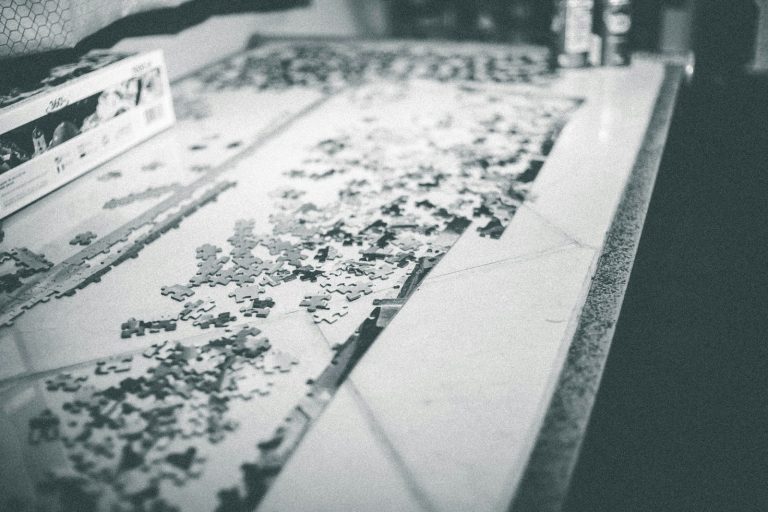Early jigsaw puzzle designs even now have long captivated the minds of both young and old, offering a blend of challenge, fun, and satisfaction upon completion. The journey of these puzzles began in the 19th century, marking the start of an enduring legacy. Initially, these puzzles featured simple designs like geometric shapes or alphabet letters, primarily targeting children.
As the century progressed, puzzle makers began to innovate, experimenting with new materials like wood and introducing more complex themes. This evolution transformed jigsaw puzzles into a beloved pastime for adults as well, transcending their original educational purpose. Let’s dive into the fascinating evolution of early jigsaw puzzle designs and how they paved the way for the intricate and captivating puzzles we enjoy today.
Evolution of Jigsaw Puzzle
In exploring the captivating world of jigsaw puzzles, it’s essential to delve into their intriguing history and the innovations that shaped their development. Through successive leaps in design and manufacturing, jigsaw puzzles have morphed from simple educational tools into complex pieces of art that puzzle enthusiasts adore. Let’s journey through the early history of jigsaw puzzles before examining how interlocking pieces became a game-changer in puzzle design.

Early History of Jigsaw Puzzles
The story begins in the mid-18th century when John Spilsbury, a London cartographer and engraver, conceived the game called jigsaw puzzles. Spilsbury mounted a world map onto a sheet of wood, carefully cutting along the borders of countries with a marquetry saw. This initial children’s puzzles was intended as an educational aid to help children learn geography in an engaging manner.
Beyond mere amusement, these early puzzles served a dual purpose: they were didactic tools that provided a hands-on approach to learning about the world. Initially, these puzzles were known as “dissected maps,” and they quickly gained popularity in aristocratic circles, where education was highly valued. Wooden puzzles of this era were handcrafted, making them luxury items accessible only to the wealthy.
As puzzles broadened in scope beyond geographical themes, they started to incorporate diverse subjects such as historical events, botanical illustrations, and famous artworks. However, the production process remained labor-intensive and costly, limiting widespread accessibility. It wasn’t until technological advancements in cutting and material processing that jigsaw puzzles became more affordable and widespread.
Introduction of Interlocking Pieces
The evolution of jigsaw puzzles saw a significant milestone with the introduction of interlocking pieces. This innovation transformed the puzzle-making industry and the puzzling experience itself. Early puzzles featured pieces that simply sat next to each other, relying on the puzzler’s ability to discern slight variations in shape or image to place them correctly. While effective for simpler designs, this method lacked the complexity and challenge that many puzzle enthusiasts craved.
It was in the late 19th century that puzzle makers began experimenting with fully interlocking pieces. This meant each piece could only fit with its correct neighbors, adding a layer of difficulty and intrigue to the puzzle-solving process. The concept of ‘tab and blank’ (also known as ‘male and female’) connections was introduced, where each piece has a part that protrudes and a corresponding part that recesses. This design ensured a more satisfying and secure fit between pieces, enhancing the tactile experience of piecing them together.
Interlocking pieces also had practical benefits. They allowed for more intricate and detailed puzzle images and made it easier to transport or move a partially completed puzzle without it falling apart. This innovation marked a turning point, making puzzles not just educational tools but also a source of entertainment and challenge for adults and children alike.
Popular Early Jigsaw Puzzle Designs
When I dive into the history of jigsaw puzzles, I can’t help but marvel at the evolution of their designs. Especially noteworthy are the designs from the early periods, which laid the foundation for today’s diverse and complex puzzles. Let’s explore some of the most popular early jigsaw puzzle designs that captivated minds and challenged puzzle enthusiasts.
Victorian Era Puzzles
During the Victorian era, jigsaw puzzles became the pinnacle of sophistication and entertainment. The designs from this period were nothing short of artistic masterpieces. Crafted meticulously by hand using a fretsaw, each piece of these puzzles was unique, adding an unparalleled layer of complexity. What stood out was the puzzles’ intricate designs and vibrant colors, which were achieved despite the limited technology of the time. Some Victorian-era puzzles even introduced extra pieces that didn’t fit anywhere in the puzzle, a clever twist that added to the challenge and fun.

Another noteworthy aspect was the thematic diversity of these puzzles. From detailed maps for educational purposes to elaborate scenes from mythology and history, these puzzles served both as a tool for learning and an opulent pastime. The rarity and craftsmanship of Victorian puzzles made them highly desirable among the upper class, solidifying their status as both a leisure activity and a symbol of social standing.
Wooden Puzzle Blocks
Before the advent of cardboard puzzles and intricate die-cut pieces, there were Wooden Puzzle Blocks. These early puzzles, often referred to as “dissected maps”, served as one of the initial forms of jigsaw puzzles. Originating in the 18th century, these puzzles were made by affixing a map or a painting to a wooden jigsaw puzzle and then cutting out the individual pieces. The simplicity and educational value of wooden puzzle blocks made them extremely popular among children and adults alike.
What made these blocks stand out was their durability and tactile experience. Unlike their cardboard descendants, wooden puzzles could withstand the wear and tear of repeated use, making them cherished heirlooms passed down through generations. Additionally, the act of physically manipulating these wooden pieces to solve a puzzle provided a more hands-on learning opportunity for children, teaching them geography, history, and literature in a tangible and engaging way.
In exploring these early puzzles, I’m reminded of the ingenuity and creativity of puzzle makers who paved the way for the complex and captivating jigsaw puzzles we enjoy today. The evolution from hand-cut wooden jigsaw puzzles to detailed and colorful puzzles of the Victorian era illustrates a remarkable journey of innovation and artistry.
Technological Advancements in Jigsaw Puzzles
As I delve deeper into the history and evolution of jigsaw puzzles, it’s impossible to overlook the significant impact of technological advancements. These innovations have not only improved the quality of puzzles but have also made them more accessible and appealing to a broader audience. Let’s explore some of the key technological leaps that have shaped the jigsaw puzzle industry.
Lithography Techniques
One of the pivotal moments in the evolution of jigsaw puzzles was the introduction of lithography techniques. This printing technology allowed for the mass production of puzzles with vibrant and detailed images, which was a game-changer. I remember reading how, before lithography, puzzles were often hand-painted or lacked colorful imagery, limiting their appeal and making them expensive to produce.
The advent of lithography paved the way for puzzles to become not only more visually engaging but also more affordable. This meant puzzles could now feature elaborate artwork, photographs, and even educational content, making them more appealing to a wider range of ages and interests.
Die-cutting Innovations
The development of die-cutting technology was another significant advancement that transformed the jigsaw puzzle industry. Initially, puzzle pieces were meticulously cut by hand, a labor-intensive process that restricted creativity in piece shapes and puzzle complexity. However, with die-cutting innovations, manufacturers could create puzzles with intricate and unique piece shapes on a much larger scale. This technology involves using sharp steel blades formed into specific patterns to cut through sheets of material, allowing for precise and consistent shapes.
The introduction of die-cutting made it possible to produce puzzles more efficiently and with greater design complexity, enhancing the puzzling experience. These innovations have led to the creation of puzzles with whimsically shaped pieces, intricate borders, and even three-dimensional puzzles, pushing the boundaries of what’s possible in puzzle design.
Exploring these technological advancements, it’s fascinating to see how much lithography and die-cutting innovations have contributed to the evolution of jigsaw puzzles. They’ve not only improved the aesthetic and tactile quality of puzzles but have also made puzzle-making an art form in its own right. As I continue to unravel the history of jigsaw puzzles, it’s clear these technologies played a crucial role in making puzzles the beloved pastime they are today.
Reflecting on the journey of jigsaw puzzles from their humble beginnings to the captivating challenges we enjoy today, it’s clear that technological advancements have played a pivotal role. The leap from simple cutouts to the vibrant, complex puzzles we see now is nothing short of remarkable. Lithography and die-cutting have not only made puzzles more accessible but have also turned them into a form of art that appeals to all ages.
As we piece together puzzles, we’re also piecing together a story of innovation and creativity that continues to evolve. It’s exciting to think about what the future holds for jigsaw puzzle designs and the new technologies that will shape them. For now, I’m grateful for the rich history and the joy these puzzles bring into our lives.
Frequently Asked Questions
Why are jigsaw puzzles so addictive?
Jigsaw puzzles are addictive because your brain releases dopamine not just when completing the puzzle, but also throughout the process, providing a rewarding and satisfying experience.
What was called the Rolls Royce of puzzles?
Stave Puzzles, known for their exceptional craftsmanship and challenging designs, are referred to as “the Rolls-Royce of Puzzles.”
What is the secret to jigsaw puzzles?
The secret to tackling jigsaw puzzles effectively includes turning all pieces right side up, starting with the border, sorting pieces by color and shape, and focusing on smaller sections within the overall image.
What is the hardest jigsaw puzzle?
The “Puzzle of Life” holds the title for the most difficult jigsaw puzzle, featuring 43,252 pieces and measuring 18ft by 6ft once completed.
What is the oldest type of puzzle?
The oldest type of puzzle is believed to be inspired by Archimedes, leading to the creation of Tangrams and Pentomino puzzles.

